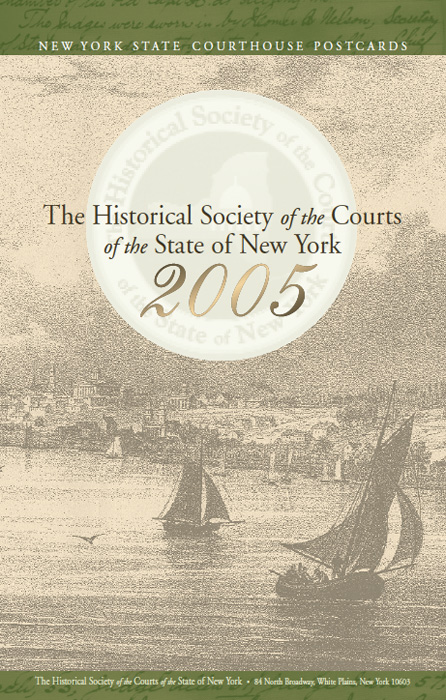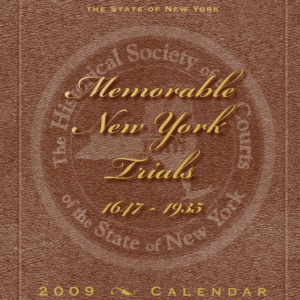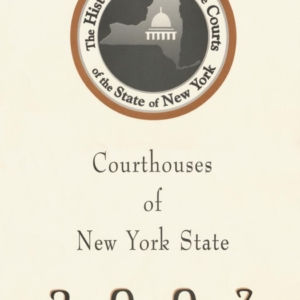Description

Ulster County Courthouse, Kingston, New York
In 1777, the first Senate of New York State fled from British forces invading New York City and took up residence further up the Hudson River at the Senate House in Kingston. In September 1777, the Senate convened at the limestone building, first erected in 1676 by Wessel Ten Broeck and generously donated to the new government by Abraham Van Gaasbeck. The Senate, however, met only for one month before the British troops converged on the Hudson Valley, causing the government to flee upriver once again. On October 16, 1777, the British army burned Kingston to the ground to punish the city for supporting the Revolution. In 1887, the State of New York acquired the Senate House and made it the second building preserved by the State for its historic value. The building reflects the architectural styles of both the Dutch and British, and is currently a museum restored to resemble how it looked in 1777. Attached to the Senate House is a two-story museum containing artwork from the Vanderlyn family of Kingston and a number of notable artists.
Sources: http://www.cr.nps.gov/nr/travel/kingston/sitelist1.htm; http://areas.wildernet.com/pages/area.cfm?areaID=NYSPSE&CU_ID=1
Ulster County Courthouse, Kingston, New York. During the Revolutionary War, this courthouse played a pivotal role in the formation of New York State’s first government. After the British captured New York City in 1776, the patriots charged with creating a new State Constitution fled New York City and eventually arrived in Kingston in February 1777. The delegates, led by John Jay, took up residence in the Ulster County Courthouse, held a Constitutional Convention and approved a new Constitution in April 1777. In September, Supreme Court opened its first term in the courthouse. A month later, 1,600 British regulars arrived and burned Kingston to the ground. The City replaced the courthouse with a larger two-story stone structure that is currently the center of the Ulster County court system. Sojourner Truth, the famous abolitionist and women’s rights activist, successfully saved her son from slavery by arguing his case here.
Source: Hon. J. Michael Bruhn, County Court Judge
February 2005
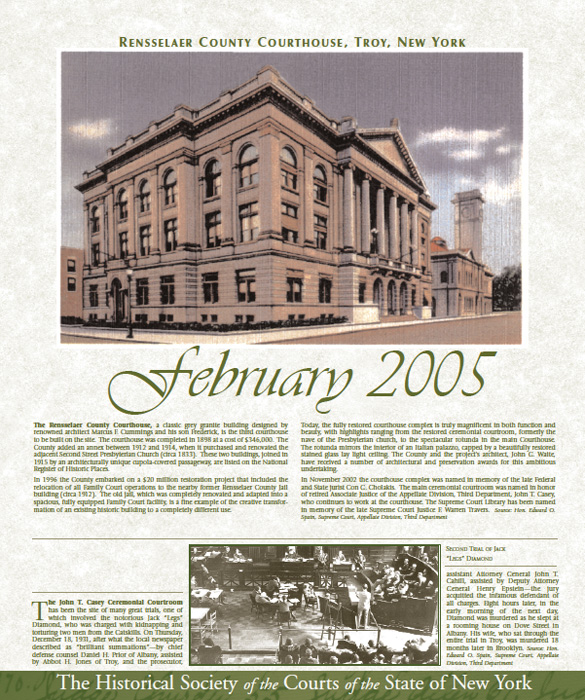
Rensselaer County Courthouse, Troy, New York
The Rensselaer County Courthouse, a classic grey granite building designed by renowned architect Marcus F. Cummings and his son Frederick, is the third courthouse to be built on the site. The courthouse was completed in 1898 at a cost of $346,000. The County added an annex between 1912 and 1914, when it purchased and renovated the adjacent Second Street Presbyterian Church (circa 1833). These two buildings, joined in 1915 by an architecturally unique cupola-covered passageway, are listed on the National Register of Historic Places.
In 1996 the County embarked on a $20 million restoration project that included the relocation of all Family Court operations to the nearby former Rensselaer County Jail building (circa 1912). The old jail, which was completely renovated and adapted into a spacious, fully equipped Family Court facility, is a fine example of the creative transformation of an existing historic building to a completely different use. Today, the fully restored courthouse complex is truly magnificent in both function and beauty, with highlights ranging from the restored ceremonial courtroom, formerly the nave of the Presbyterian church, to the spectacular rotunda in the main Courthouse. The rotunda mirrors the interior of an Italian palazzo, capped by a beautifully restored stained glass lay light ceiling. The County and the project”s architect, John G. Waite, have received a number of architectural and preservation awards for this ambitious undertaking.
In November 2002 the courthouse complex was named in memory of the late Federal and State jurist Con G. Cholakis. The main ceremonial courtroom was named in honor of retired Associate Justice of the Appellate Division, Third Department, John T. Casey, who continues to work at the courthouse. The Supreme Court Library has been named in memory of the late Supreme Court Justice F. Warren Travers. Source: Hon. Edward O. Spain, Supreme Court, Appellate Division, Third Department.
The John T. Casey Ceremonial Courtroom has been the site of many great trials, one of which involved the notorious Jack ‘Legs’ Diamond, who was charged with kidnapping and torturing two men from the Catskills. On Thursday, December 18, 1931, after what the local newspaper described as ‘brilliant summations,’ by chief defense counsel Daniel H. Prior of Albany, assisted by Abbot H. Jones of Troy, and the prosecutor, assistant Attorney General John T. Cahill, assisted by Deputy Attorney General Henry Epstein—the jury acquitted the infamous defendant of all charges. Eight hours later, in the early morning of the next day, Diamond was murdered as he slept at a rooming house on Dove Street in Albany. His wife, who sat through the entire trial in Troy, was murdered 18 months later in Brooklyn.
Source: Hon. Edward O. Spain, Supreme Court, Appellate Division, Third Department
March 2005
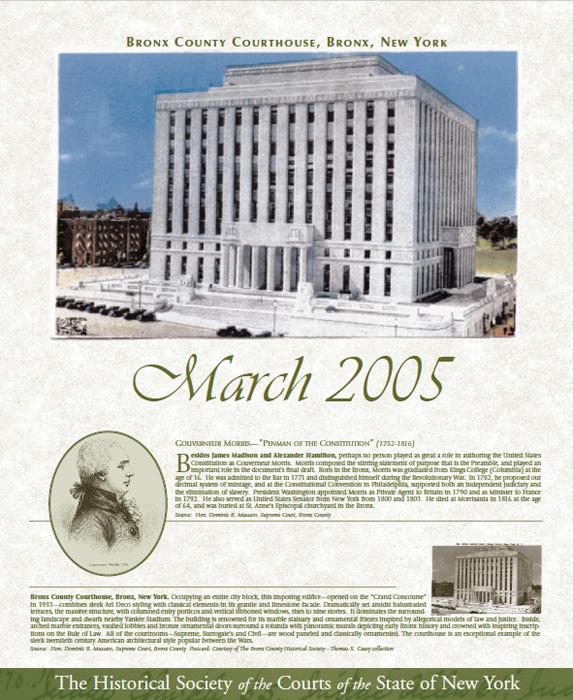
Bronx County Courthouse, Bronx, New York
GOUVERNEUR MORRIS—’PENMAN OF THE CONSTITUTION’ (1752-1816)
Besides James Madison and Alexander Hamilton, perhaps no person played as great a role in authoring the United States Constitution as Gouverneur Morris. Morris composed the stirring statement of purpose that is the Preamble, and played an important role in the document’s final draft. Born in the Bronx, Morris was graduated from Kings College (Columbia) at the age of 16. He was admitted to the Bar in 1771 and distinguished himself during the Revolutionary War. In 1782, he proposed our decimal system of mintage, and at the Constitutional Convention in Philadelphia, supported both an independent judiciary and the elimination of slavery. President Washington appointed Morris as Private Agent to Britain in 1790 and as Minister to France in 1792. He also served as United States Senator from New York from 1800 and 1803. He died at Morrisania in 1816 at the age of 64, and was buried at St. Anne’s Episcopal churchyard in the Bronx.
Source: Hon. Dominic R. Massaro, Supreme Court, Bronx County
Bronx County Courthouse, Bronx, New York. Occupying an entire city block, this imposing edifice—opened on the ‘Grand Concourse’ in 1933—combines sleek Art Deco styling with classical elements in its granite and limestone facade. Dramatically set amidst balustraded terraces, the massive structure, with columned entry porticos and vertical ribboned windows, rises to nine stories. It dominates the surrounding landscape and dwarfs nearby Yankee Stadium. The building is renowned for its marble statuary and ornamental friezes inspired by allegorical models of law and justice. Inside, arched marble entrances, vaulted lobbies and bronze ornamental doors surround a rotunda with panoramic murals depicting early Bronx history and crowned with inspiring inscriptions on the Rule of Law. All of the courtrooms—Supreme, Surrogate’s and Civil—are wood paneled and classically ornamented. The courthouse is an exceptional example of the sleek twentieth century American architectural style popular between the Wars.
Source: Hon. Dominic R. Massaro, Supreme Court, Bronx County Postcard: Courtesy of The Bronx County Historical Society—Thomas X. Casey collection
April 2005
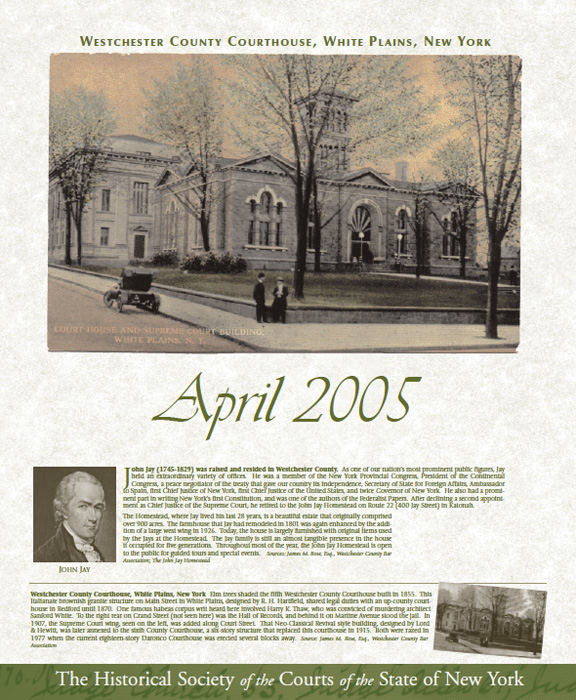
Westchester County Courthouse, White Plains, New York
John Jay (1745-1829) was raised and resided in Westchester County. As one of our nation’s most prominent public figures, Jay held an extraordinary variety of offices. He was a member of the New York Provincial Congress, President of the Continental Congress, a peace negotiator of the treaty that gave our country its independence, Secretary of State for Foreign Affairs, Ambassador to Spain, first Chief Justice of New York, first Chief Justice of the United States, and twice Governor of New York. He also had a prominent part in writing New York”s first Constitution, and was one of the authors of the Federalist Papers. After declining a second appointment as Chief Justice of the Supreme Court, he retired to the John Jay Homestead on Route 22 (400 Jay Street) in Katonah.
The Homestead, where Jay lived his last 28 years, is a beautiful estate that originally comprised over 900 acres. The farmhouse that Jay had remodeled in 1801 was again enhanced by the addition of a large west wing in 1926. Today, the house is largely furnished with original items used by the Jays at the Homestead. The Jay family is still an almost tangible presence in the house it occupied for five generations. Throughout most of the year, the John Jay Homestead is open to the public for guided tours and special events.
Sources: James M. Rose, Esq., Westchester County Bar Association; The John Jay Homestead
Westchester County Courthouse, White Plains, New York Elm trees shaded the fifth Westchester County Courthouse built in 1855. This Italianate brownish granite structure on Main Street in White Plains, designed by R. H. Hartfield, shared legal duties with an up-county courthouse in Bedford until 1870. One famous habeas corpus writ heard here involved Harry K. Thaw, who was convicted of murdering architect Sanford White. To the right rear on Grand Street (not seen here) was the Hall of Records, and behind it on Martine Avenue stood the jail. In 1907, the Supreme Court wing, seen on the left, was added along Court Street. That Neo-Classical Revival style building, designed by Lord & Hewitt, was later annexed to the sixth County Courthouse, a six-story structure that replaced this courthouse in 1915. Both were razed in 1977 when the current eighteen-story Daronco Courthouse was erected several blocks away.
Source: James M. Rose, Esq., Westchester County Bar Association
May 2005
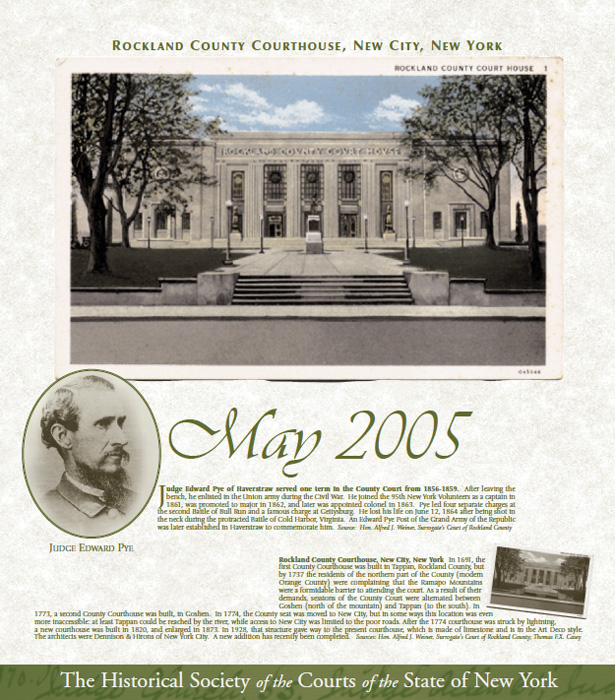
Rockland County Courthouse, New City, New York
Judge Edward Pye of Haverstraw served one term in the County Court from 1856-1859. After leaving the bench, he enlisted in the Union army during the Civil War. He joined the 95th New York Volunteers as a captain in 1861, was promoted to major in 1862, and later was appointed colonel in 1863. Pye led four separate charges at the second Battle of Bull Run and a famous charge at Gettysburg. He lost his life on June 12, 1864 after being shot in the neck during the protracted Battle of Cold Harbor, Virginia. An Edward Pye Post of the Grand Army of the Republic was later established in Haverstraw to commemorate him.
Source: Hon. Alfred J. Weiner, Surrogate’s Court of Rockland County
Rockland County Courthouse, New City, New York In 1691, the first County Courthouse was built in Tappan, Rockland County, but by 1737 the residents of the northern part of the County (modern Orange County) were complaining that the Ramapo Mountains were a formidable barrier to attending the court. As a result of their demands, sessions of the County Court were alternated between Goshen (north of the mountain) and Tappan (to the south). In 1773, a second County Courthouse was built, in Goshen. In 1774, the County seat was moved to New City, but in some ways this location was even more inaccessible: at least Tappan could be reached by the river, while access to New City was limited to the poor roads. After the 1774 courthouse was struck by lightning, a new courthouse was built in 1820, and enlarged in 1873. In 1928, that structure gave way to the present courthouse, which is made of limestone and is in the Art Deco style. The architects were Dennison & Hirons of New York City. A new addition has recently been completed.
Sources: Hon. Alfred J. Weiner, Surrogate’s Court of Rockland County; Thomas F.X. Casey
June 2005

Old Clinton County Courthouse, Plattsburgh, New York
Old Clinton County Courthouse, Plattsburgh, New York. After the Surrogate’s Building was completed in 1884, the Sheriff and other officials began to complain about its inadequacies. Using plans from Albany, locally quarried stone, iron laden brick from Pennsylvania and cast-iron lintels made from melted-down Civil War cannons, the County completed construction of the imposing Romanesque Italianate County Courthouse in 1889, at a cost of $40,000. Its bell was formerly used in the 1884 courthouse, and bears the stamp ‘A. Menneley W. Troy NY 1851.’ On the National Register of Historic Places, the formidable 1889 courthouse became a central landmark in the Village of Plattsburgh. Plattsburgh was incorporated as a city in 1902, and City Court was held in the 1889 courthouse from 1906-1919. Presently, the 1889 courthouse houses the County Health Department and the STOP-DWI Program.
Sources: Addie Shields, Clinton County Historian; Hon. Penelope D. Clute, Plattsburgh City Court Judge; ‘Plattsburgh, New York—A City’s First Century’ by Richard B. Frost.
The ties between Clinton County and the United States Constitution are strong, forged by those who played a role in the Constitution”s ratification after the Revolutionary War. Zephaniah Platt (1735-1807), one of the founders of Plattsburgh in the 1780s, had been a Dutchess County Judge and a member of the convention that ratified the Constitution in Poughkeepsie (then the State’s capital) in 1788. Zephaniah’s brother, Nathaniel (1741-1816), left, another of Plattsburgh’s founders, had been captain of a Dutchess County Company in the French and Indian War in 1760. Zephaniah Platt’s son, Judge Jonas Platt (1769-1834), was a State Senator and member of Congress. At the State Constitutional Convention in 1821, Senator Platt spoke stirringly against the ‘odious discrimination of colour.’ Of the Platt founders, Nathaniel Platt is evidently the only one to have had his portrait painted.
Another of Plattsburgh’s pioneers, Melancton Smith (1744-1798), second from the left in painting below, played a key role in New York’s ratification of the United States Constitution in 1788. That year’s Constitutional Convention was chaired by Governor George Clinton (1739-1812), after whom Clinton County was named.
Sources: The Plattsburgh Platts, by Margaret Meyers Byrne (1991); The Reluctant Pillar: New York and the Adoption of the Federal Constitution, by Stephen L. Schechter (Troy, N.Y., Russell Sage College 1985); Rear Admiral Melancton Smith, U.S.N.óA Memoir, by Reuben Gold Thwaites (1893)
July 2005
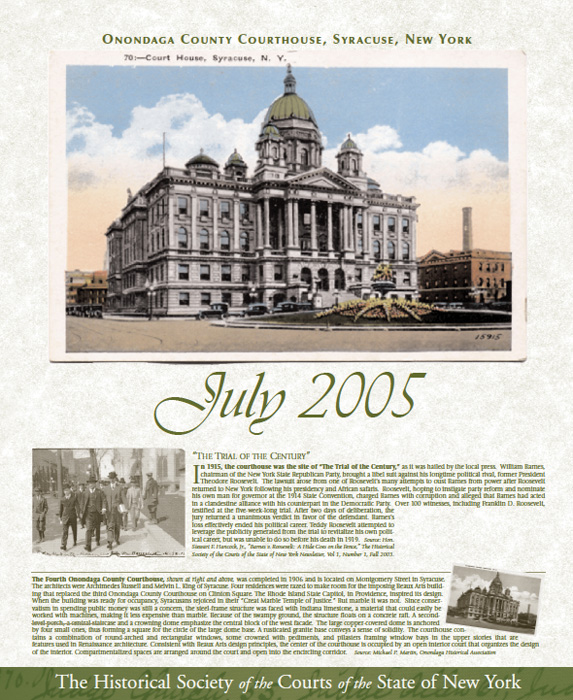
Onondaga County Courthouse, Syracuse, New York
‘THE TRIAL OF THE CENTURY’
In 1915, the courthouse was the site of ‘The Trial of the Century,’ as it was hailed by the local press. William Barnes, chairman of the New York State Republican Party, brought a libel suit against his longtime political rival, former President Theodore Roosevelt. The lawsuit arose from one of Roosevelt’s many attempts to oust Barnes from power after Roosevelt returned to New York following his presidency and African safaris. Roosevelt, hoping to instigate party reform and nominate his own man for governor at the 1914 State Convention, charged Barnes with corruption and alleged that Barnes had acted in a clandestine alliance with his counterpart in the Democratic Party. Over 100 witnesses, including Franklin D. Roosevelt, testified at the five-week-long trial. After two days of deliberation, the jury returned a unanimous verdict in favor of the defendant. Barnes’s loss effectively ended his political career. Teddy Roosevelt attempted to leverage the publicity generated from the trial to revitalize his own political career, but was unable to do so before his death in 1919.
Source: Hon. Stewart F. Hancock, Jr., ìBarnes v. Roosevelt: A Hide Goes on the Fence,î The Historical Society of the Courts of the State of New York Newsletter, Vol 1, Number 1, Fall 2003.
The Fourth Onondaga County Courthouse, shown at right and above, was completed in 1906 and is located on Montgomery Street in Syracuse. The architects were Archimedes Russell and Melvin L. King of Syracuse. Four residences were razed to make room for the imposing Beaux Arts building that replaced the third Onondaga County Courthouse on Clinton Square. The Rhode Island State Capitol, in Providence, inspired its design. When the building was ready for occupancy, Syracusans rejoiced in their iGreat Marble Temple of Justice.i But marble it was not. Since conservatism in spending public money was still a concern, the steel-frame structure was faced with Indiana limestone, a material that could easily be worked with machines, making it less expensive than marble. Because of the swampy ground, the structure floats on a concrete raft. A second level porch, a central staircase and a crowning dome emphasize the central block of the west facade. The large copper-covered dome is anchored by four small ones, thus forming a square for the circle of the large dome base. A rusticated granite base conveys a sense of solidity. The courthouse contains a combination of round-arched and rectangular windows, some crowned with pediments, and pilasters framing window bays in the upper stories that are features used in Renaissance architecture. Consistent with Beaux Arts design principles, the center of the courthouse is occupied by an open interior court that organizes the design of the interior. Compartmentalized spaces are arranged around the court and open into the encircling corridor.
Source: Michael P. Martin, Onondaga Historical Association
August 2005
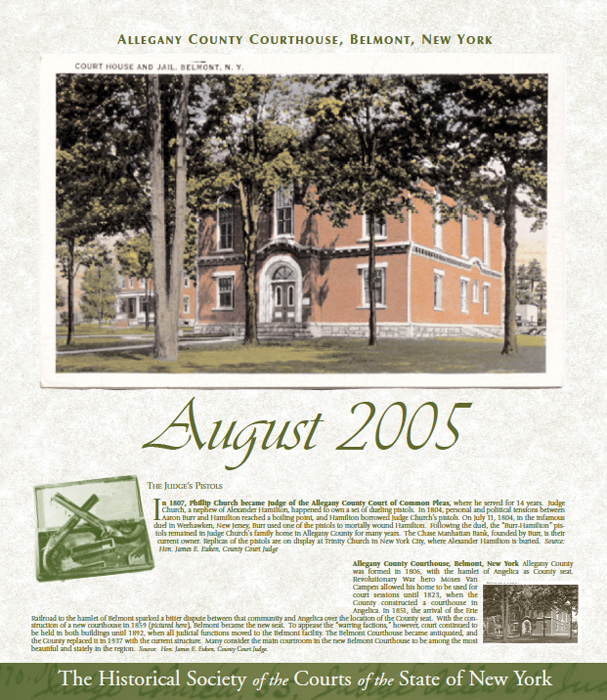
Allegany County Courthouse, Belmont, New York
THE JUDGE’S PISTOLS
In 1807, Phillip Church became Judge of the Allegany County Court of Common Pleas, where he served for 14 years. Judge Church, a nephew of Alexander Hamilton, happened to own a set of dueling pistols. In 1804, personal and political tensions between Aaron Burr and Hamilton reached a boiling point, and Hamilton borrowed Judge Church’s pistols. On July 11, 1804, in the infamous duel in Weehawken, New Jersey, Burr used one of the pistols to mortally wound Hamilton. Following the duel, the ‘Burr-Hamilton’ pistols remained in Judge Church’s family home in Allegany County for many years. The Chase Manhattan Bank, founded by Burr, is their current owner. Replicas of the pistols are on display at Trinity Church in New York City, where Alexander Hamilton is buried.
Source: Hon. James E. Euken, County Court Judge
Allegany County Courthouse, Belmont, New York Allegany County was formed in 1806, with the hamlet of Angelica as County seat. Revolutionary War hero Moses Van Campen allowed his home to be used for court sessions until 1823, when the County constructed a courthouse in Angelica. In 1851, the arrival of the Erie Railroad to the hamlet of Belmont sparked a bitter dispute between that community and Angelica over the location of the County seat. With the construction of a new courthouse in 1859 (pictured here), Belmont became the new seat. To appease the ‘warring factions,’ however, court continued to be held in both buildings until 1892, when all judicial functions moved to the Belmont facility. The Belmont Courthouse became antiquated, and the County replaced it in 1937 with the current structure. Many consider the main courtroom in the new Belmont Courthouse to be among the most beautiful and stately in the region.
Source: Hon. James E. Euken, County Court Judge.
September 2005
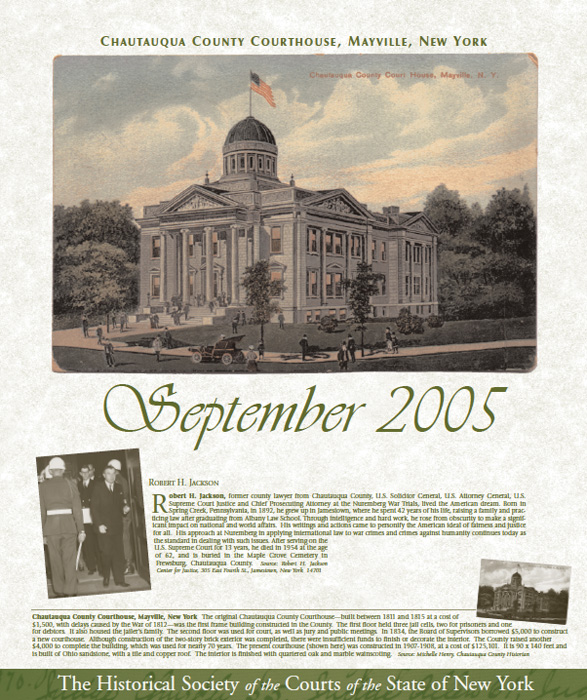
Chautauqua County Courthouse, Mayville, New York
ROBERT H. JACKSON
Robert H. Jackson, former county lawyer from Chautauqua County, U.S. Solicitor General, U.S. Attorney General, U.S. Supreme Court Justice and Chief Prosecuting Attorney at the Nuremberg War Trials, lived the American dream. Born in Spring Creek, Pennsylvania, in 1892, he grew up in Jamestown, where he spent 42 years of his life, raising a family and practicing law after graduating from Albany Law School. Through intelligence and hard work, he rose from obscurity to make a significant impact on national and world affairs. His writings and actions came to personify the American ideal of fairness and justice for all. His approach at Nuremberg in applying international law to war crimes and crimes against humanity continues today as the standard in dealing with such issues. After serving on the U.S. Supreme Court for 13 years, he died in 1954 at the age of 62, and is buried in the Maple Grove Cemetery in Frewsburg, Chautauqua County.
Source: Robert H. Jackson Center for Justice, 305 East Fourth St., Jamestown, New York 14701
Chautauqua County Courthouse, Mayville, New York The original Chautauqua County Courthouse—built between 1811 and 1815 at a cost of $1,500, with delays caused by the War of 1812—was the first frame building constructed in the County. The first floor held three jail cells, two for prisoners and one for debtors. It also housed the jailer’s family. The second floor was used for court, as well as jury and public meetings. In 1834, the Board of Supervisors borrowed $5,000 to construct a new courthouse. Although construction of the two-story brick exterior was completed, there were insufficient funds to finish or decorate the interior. The County raised another $4,000 to complete the building, which was used for nearly 70 years. The present courthouse (shown here) was constructed in 1907-1908, at a cost of $125,101. It is 90 x 140 feet and is built of Ohio sandstone, with a tile and copper roof. The interior is finished with quartered oak and marble wainscoting.
Source: Michelle Henry, Chautauqua County Historian
October 2005
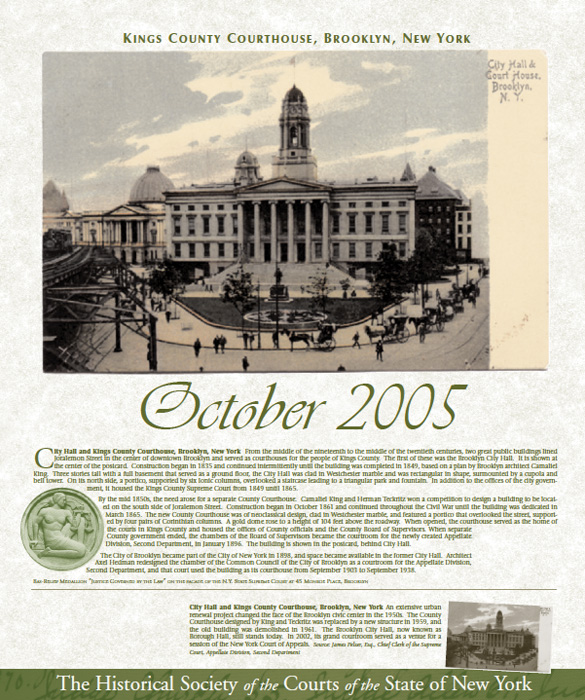
Kings County Courthouse, Brooklyn, New York
City Hall and Kings County Courthouse, Brooklyn, New York From the middle of the nineteenth to the middle of the twentieth centuries, two great public buildings lined Joralemon Street in the center of downtown Brooklyn and served as courthouses for the people of Kings County. The first of these was the Brooklyn City Hall. It is shown at the center of the postcard. Construction began in 1835 and continued intermittently until the building was completed in 1849, based on a plan by Brooklyn architect Gamaliel King. Three stories tall with a full basement that served as a ground floor, the City Hall was clad in Westchester marble and was rectangular in shape, surmounted by a cupola and bell tower. On its north side, a portico, supported by six Ionic columns, overlooked a staircase leading to a triangular park and fountain. In addition to the offices of the city government, it housed the Kings County Supreme Court from 1849 until 1865.
By the mid 1850s, the need arose for a separate County Courthouse. Gamaliel King and Herman Teckritz won a competition to design a building to be located on the south side of Joralemon Street. Construction began in October 1861 and continued throughout the Civil War until the building was dedicated in March 1865. The new County Courthouse was of neoclassical design, clad in Westchester marble, and featured a portico that overlooked the street, supported by four pairs of Corinthian columns. A gold dome rose to a height of 104 feet above the roadway. When opened, the courthouse served as the home of the courts in Kings County and housed the offices of County officials and the County Board of Supervisors. When separate County government ended, the chambers of the Board of Supervisors became the courtroom for the newly created Appellate Division, Second Department, in January 1896. The building is shown in the postcard, behind City Hall.
The City of Brooklyn became part of the City of New York in 1898, and space became available in the former City Hall. ArchitectAxel Hedman redesigned the chamber of the Common Council of the City of Brooklyn as a courtroom for the Appellate Division, Second Department, and that court used the building as its courthouse from September 1903 to September 1938.
City Hall and Kings County Courthouse, Brooklyn, New York An extensive urban renewal project changed the face of the Brooklyn civic center in the 1950s. The County Courthouse designed by King and Teckritz was replaced by a new structure in 1959, and the old building was demolished in 1961. The Brooklyn City Hall, now known as Borough Hall, still stands today. In 2002, its grand courtroom served as a venue for a session of the New York Court of Appeals.
Source: James Pelzer, Esq., Chief Clerk of the Supreme Court, Appellate Division, Second Department
November 2005
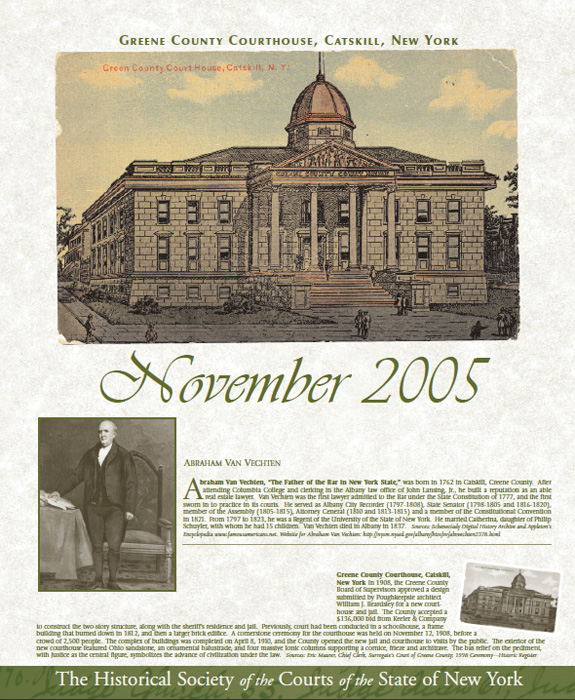
Greene County Courthouse, Catskill, New York
ABRAHAM VAN VECHTEN
Abraham Van Vechten, ‘The Father of the Bar in New York State,’ was born in 1762 in Catskill, Greene County. After attending Columbia College and clerking in the Albany law office of John Lansing, Jr., he built a reputation as an able real estate lawyer. Van Vechten was the first lawyer admitted to the Bar under the State Constitution of 1777, and the first sworn in to practice in its courts. He served as Albany City Recorder (1797-1808), State Senator (1798-1805 and 1816-1820), member of the Assembly (1805-1815), Attorney General (1810 and 1813-1815) and a member of the Constitutional Convention in 1821. From 1797 to 1823, he was a Regent of the University of the State of New York. He married Catherina, daughter of Philip Schuyler, with whom he had 15 children. Van Vechten died in Albany in 1837.
Sources: Schenectady Digital History Archive and Appleton’s Encyclopedia www.famousamericans.net. Website for Abraham Van Vechten: http://nysm.nysed.gov/albany/bios/vv/abvvechten2378.html
Greene County Courthouse, Catskill, New York In 1908, the Greene County Board of Supervisors approved a design submitted by Poughkeepsie architect William J. Beardsley for a new courthouse and jail. The County accepted a $136,000 bid from Keeler & Company to construct the two-story structure, along with the sheriff’s residence and jail. Previously, court had been conducted in a schoolhouse, a frame building that burned down in 1812, and then a larger brick edifice. A cornerstone ceremony for the courthouse was held on November 12, 1908, before a crowd of 2,500 people. The complex of buildings was completed on April 8, 1910, and the County opened the new jail and courthouse to visits by the public. The exterior of the new courthouse featured Ohio sandstone, an ornamental balustrade, and four massive Ionic columns supporting a cornice, frieze and architrave. The bas relief on the pediment, with Justice as the central figure, symbolizes the advance of civilization under the law.
Sources: Eric Maurer, Chief Clerk, Surrogate’s Court of Greene County; 1998 Ceremony—Historic Register
December 2005
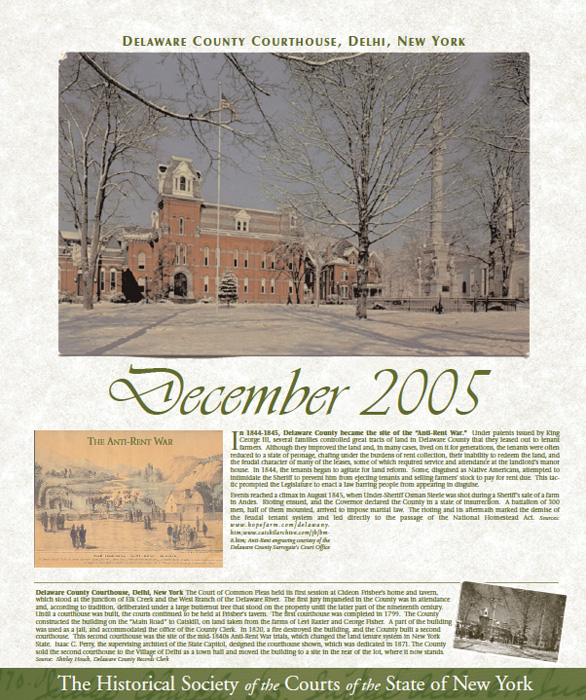
Delaware County Courthouse, Delhi, New York
In 1844-1845, Delaware County became the site of the Anti-Rent War. Under patents issued by King George III, several families controlled great tracts of land in Delaware County that they leased out to tenant farmers. Although they improved the land and, in many cases, lived on it for generations, the tenants were often reduced to a state of peonage, chafing under the burdens of rent collection, their inability to redeem the land, and the feudal character of many of the leases, some of which required service and attendance at the landlord’s manor house. In 1844, the tenants began to agitate for land reform. Some, disguised as Native Americans, attempted to intimidate the Sheriff to prevent him from ejecting tenants and selling farmers’ stock to pay for rent due. This tactic prompted the Legislature to enact a law barring people from appearing in disguise.
Events reached a climax in August 1845, when Under-Sheriff Osman Steele was shot during a Sheriff’s sale of a farm in Andes. Rioting ensued, and the Governor declared the County in a state of insurrection. A battalion of 300 men, half of them mounted, arrived to impose martial law. The rioting and its aftermath marked the demise of the feudal tenant system and led directly to the passage of the National Homestead Act.
Sources: www.hopefarm.com/delawany.htm;www.catskilarchive.com/jb/bm-8.htm; Anti-Rent engraving courtesy of the Delaware County Surrogate’s Court Office
Delaware County Courthouse, Delhi, New York. The Court of Common Pleas held its first session at Gideon Frisbee’s home and tavern, which stood at the junction of Elk Creek and the West Branch of the Delaware River. The first jury impaneled in the County was in attendance and, according to tradition, deliberated under a large butternut tree that stood on the property until the latter part of the nineteenth century. Until a courthouse was built, the courts continued to be held at Frisbee’s farm. The first courthouse was completed in 1799. The County constructed the building on the”Main Road” to Catskill, on land taken from the farms of Levi Baxter and George Fisher. A part of the building was used as a jail, and accommodated the office of the County Clerk. In 1820, a fire destroyed the building, and the County build a second courthouse. This second courthouse was the site of the mid-1840s Anti-Rent War trials, which changed the land tenure system in New York State. Isaac G. Perry, the supervising architect of the State Capitol, designed the courthouse shown, which was dedicated in 1871. The County sold the second courthouse to the Village of Delhi as a town hall and moved the building to a site in the rear of the lot, where it now stands.
Source: Shirley Houck, Delaware County Records Clerk

